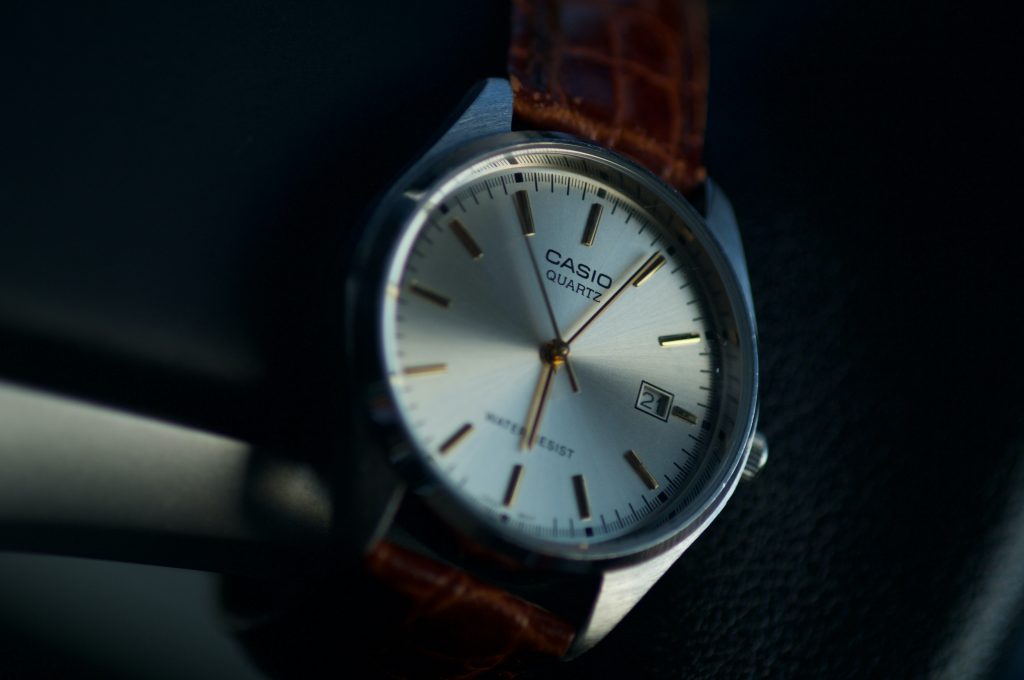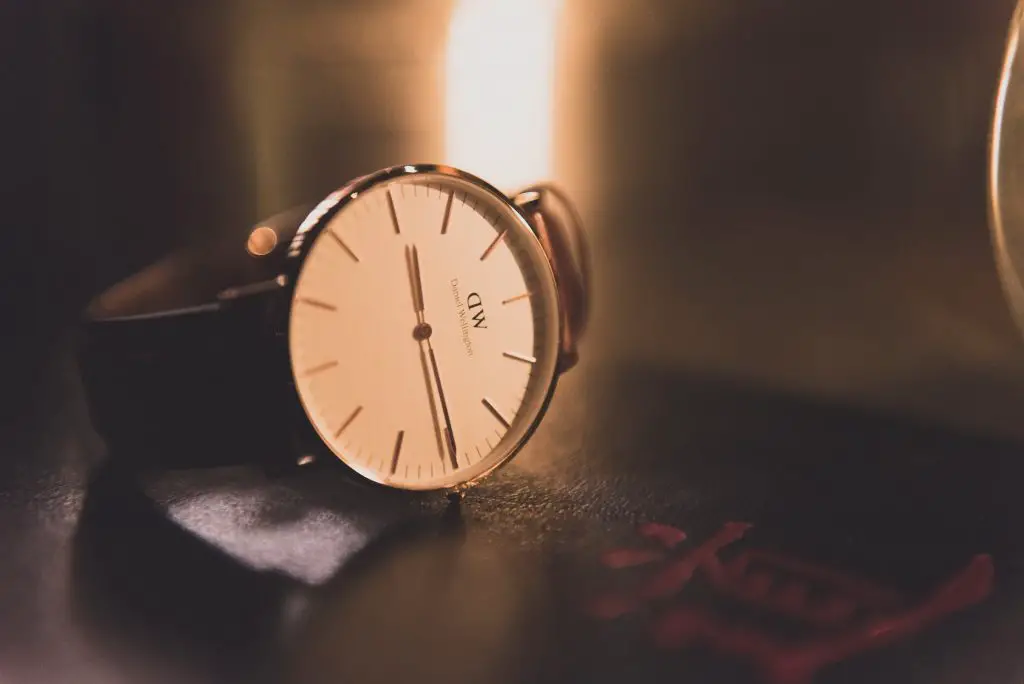Watches are intricate little accessories, and a lot is going on inside a watch. Quartz watches are some of the most popular ones, but how do they work? If you want a comprehensive guide about quartz watches detailing how they work and what parts they have, we’ve got you covered.
Quartz watches use a battery that sends an electric current to the circuit, which powers the stepping motor to convert pulses from the quartz crystal’s vibrations into mechanical energy, turning the gears inside the watch, making it work.
We understand that quartz watches can be confusing (How are they different? Are they better than watches with automatic or mechanical movements? Do they require servicing? How accurate are they?), so we put together this post giving you the details on how quartz watches work. There’s nothing too sciency in this post, just the facts you need to know!

Table of Contents
How Do Quartz Watches Work
Most quartz watches are powered by a replaceable battery, though some quartz watches use solar energy to power the watch’s movement instead of a battery. Battery or not, every quartz watch uses a tiny piece of quartz tucked inside the case to create the electronic movement needed to work.
So how, in detail, does a quartz watch work?
Inside the watch case is a small piece of low-frequency quartz crystal. Harder than granite and the most abundant mineral on the earth’s surface, quartz is an igneous crystalline mineral made up of silica – aka silicon dioxide. The quartz crystal is either shaped like a tuning fork or chemically shaped into place on the circuit board of a quartz watch. This piece of quartz is the oscillator, meaning it vibrates back and forth.
To start, a battery provides electricity to the electronic microchip circuit. When the battery transmits electricity through the circuit to the quartz crystal, the crystal vibrates or oscillates in response to the electricity. The circuit makes the quartz crystal vibrate at precisely 32,768 times per second. This process is very accurate and makes quartz watches keep more accurate time than automatic and mechanical watches.
After the quartz crystal starts to vibrate, a separate microchip circuit counts each vibration and generates consistent electric pulses at one pulse per second. These pulses power the electric stepping motor, which then turns other smaller gears inside the case. These gears turn the watch’s hands by generating electric pulses to activate the stepping motor, electrical energy inside the watch converts to mechanical energy. This is the process that makes quartz watches work.

Components That Power Quartz Watch Movement
We’ve already talked about the battery, circuit boards, and quartz crystal that work together to power the caliber, but let’s talk in more detail about the different parts that make up a quartz watch’s movement.
The Battery
The battery is the watch’s power source. Batteries typically last between 1-5 years before needing replacement.
The Electric Stepping Motor
The electric stepping motor converts electrical energy from the quartz vibrations into mechanical power that turns the gears.
The Integrated Circuit
The integrated circuit carries electrical charges to different watch parts, like the battery and quartz crystal.
The Quartz Crystal Oscillator
The crystal piece inside the watch vibrates when the battery’s electricity hits it, generating power.
The Gear Train
The gear train is the set of gears that work together to make the hands on the dial move. The gears regulate the energy produced by the stepping motor to power the hands.
The Central Shaft
The central shaft holds the two watch hands to stay in place.
The Crown
The crown screw is used to set the time. Found at the side of your watch, it sticks out a little.
How Do Quartz Watches Differ From Other Watches?
Quartz watches are very different from automatic and mechanical movement watches in that quartz watches are powered by a battery and piece of quartz crystal, whereas the latter two types of movement require work from the wearer – either by manual winding (mechanical) or physical wearing (automatic).
Read on to learn how a quartz watch differs from automatic and mechanical watches.
Quartz Movement Versus Automatic Movement
The main difference between quartz and automatic watches is that quartz watches need a battery and quartz crystal to work. In contrast, automatic watches require physical movement via stored energy in the mainspring.
Though the science behind how quartz watches work is quite complicated, there aren’t as many complex components inside a quartz watch as there are in automatic watches. This is why quartz watches are typically much cheaper than automatic timepieces – they are cheaper to make and less costly to fix.
Quartz watches will also work regardless of whether you’re wearing the watch or not. Automatic watches require movement, but they also have a power reserve, usually up to 48 hours. After those hours, the watch will no longer be tracking time and needs to be adjusted again. To learn more, read this article about how automatic watches work!
Quartz Movement Versus Mechanical Movement
The difference between quartz and mechanical movement is that mechanical movement requires the crown to be manually wound. For a mechanical watch to function, the wearer must rotate the crown at the side of the case – usually twice a day.
Quartz watches are much easier to wear in the sense of forgetfulness – you don’t have to remember to wind them manually, and only the battery needs to change every few years!
Quarts watches are really the most common and easy-to-use watches. They will keep the time correctly and accurately, regardless of whether you wear it or not. There’s also no need for winding it manually either. However, due to their simplicity, most quartz watches don’t have that many complications either. They’re fairly straightforward watches, perfect for the general masses, but maybe not as sought after by watch enthusiasts.
Are Quartz Watches Better Than Automatic Or Mechanical Watches?

Quartz watches are more accurate and less expensive to repair or replace than watches with automatic or mechanical movements. Quartz watches also tend to be cheaper since only the battery needs replacing when it’s lost its charge. They do, however, have fewer complications, making them less intricate and unique.
While automatic and mechanical watches are insanely accurate today, quartz watches are more accurate than their watch counterparts. For the record, automatic watches are 99.7% accurate. They may potentially be off by less than 25 seconds.
Mechanical watches are somewhat outdated in terms of accuracy, losing about 5-10 seconds a day. The mechanical watches aren’t as accurate because the metal components inside the case slightly expand and contract when the temperature changes, skewing accuracy.
But the accuracy of quartz watches and their batteries is nearly unrivaled. Although they require less craftsmanship, they do ultimately track the time more accurately.
Quartz watches are also cheaper to repair than automatic and mechanical watches. A new battery may cost around $40, but an automatic or mechanical movement repair can run anywhere between $50-$200 upwards.
That being said, quartz watches will also feature fewer complications and be overall more straightforward. Automatic and mechanical watches are usually made with extreme care. Most luxury watch brands only produce automatic and mechanical watches because these types of watches actually require an intricate movement.
We say that quartz watches are the better pick when you want an inexpensive, low maintenance, yet durable watch. If you’re looking for a quality timepiece that lasts generations, it may be better to go for automatic or mechanical watches.
Quartz Versus Solar Quartz – What’s The Difference?
Solar quartz watches have a solar cell underneath the dial which converts solar energy – sunlight – into electricity to power the watch, whereas a normal quartz watch utilizes a battery. Both quartz and solar quartz watches have a tiny piece of quartz crystal to generate power. However, they get their power from different sources.
A regular quartz watch only uses a battery and is not powered by sunlight. Solar quartz watches are. There’s a tiny little solar cell underneath the dial that picks up the sunlight. This is then turned into a small electric current that powers the watch. Excess energy is stored in either a capacitor or battery.
How Accurate Are Quartz Watches
Quartz watches are extremely accurate, losing only a few seconds a year. The battery, combined with the quartz crystal, makes for extreme accuracy not found in other watches.
Quartz watches are without a doubt the most accurate watches there are. Due to their electric-powered movement, they can be made so accurate that they only lose a few seconds a year. This is amazing, especially compared to automatic and mechanical watches.
Automatic watches can lose about 25 seconds per day, and mechanical watches can lose about 5-10 seconds a day. Compare that to a few seconds a year, and you can see a clear difference. You really need to wear your quartz watch for a few years in order to notice this inaccuracy.
Do Quartz Watches Have Batteries
Quartz watches do have batteries. The battery in a quartz watch is the power source and must be replaced once it’s lost charge. Quartz batteries typically require replacement within 1 – 5 years.
A battery is one of the defining features of a quartz watch. They ensure your watch works perfectly until the battery runs out. Up to that point, though, the battery ensures everything works smoothly.
How Long Do Quartz Watches Last

Quartz watches can last a few decades; on average, they last about 20 – 30 years. The battery of a quartz watch will typically last around 5 years, so it needs to be changed every 5 years.
Aside from the battery, all components of a quartz watch are made to last. Depending on the quality of your watch, it might last a few years or a few decades.
Internal parts may need servicing or to be replaced – especially the battery every few years – but quartz watches can last a very long time.
Do Quartz Watches Need Servicing
Quartz watches don’t typically need servicing as much as automatic or mechanical watches, but a service is recommended every few years. They don’t need as much servicing since there aren’t as many parts inside the case to break, but the ones there could eventually wear down.
The only moving parts inside a quartz watch are the gears that move the hands. Although these are very durable and won’t break easily, they can eventually wear down. But generally, besides changing out the battery, quartz watches are very low maintenance.
To service a quartz watch, it usually only needs to have the case opened, the battery changed, and any dirt and debris cleaned off. Some higher-end quartz analog watches may require lubrication for the gear train. Quartz watches with additional features like a compass, stopwatch, thermometer, barometer, GPS, or electric illumination may go through batteries more quickly as well.
How Much Does It Cost To Replace A Quartz Watch Battery
It costs about $10 – $45 for a battery replacement service at a local shop.
Quartz battery replacements really aren’t that expensive. The batteries used are fairly cheap, and there isn’t much labor involved either, leading to a price of about $10 – $45.
Are All Battery-Powered Watches Quartz?
Not every quartz watch is battery-powered. Instead, some quartz timepieces are powered by solar energy from light, such as with Citizen’s trendy Eco-Drive line of Casio’s watches with “tough solar” technology.
These quartz watches that get their power from artificial and natural light are solar-powered. Solar-powered watches typically can go for months without needing exposure to light once fully charged. Another excellent watch option for forgetful manual watch winders!
Do You Need A Watch Winder For Quartz Watches?
Watch winders are unnecessary for quartz watches. Watch winders wind up your automatic watches to ensure they don’t stop working. Since quartz watches are powered by electric currents, either from batteries or solar cells, they don’t require to be wound.
Only automatic watches should use a watch winder, a box-shaped place to put your watch, so it stays charged and ready to wear. It works by gently rotating your watch, mimicking your wrist as if you were wearing it, keeping your timepiece fully wound.
